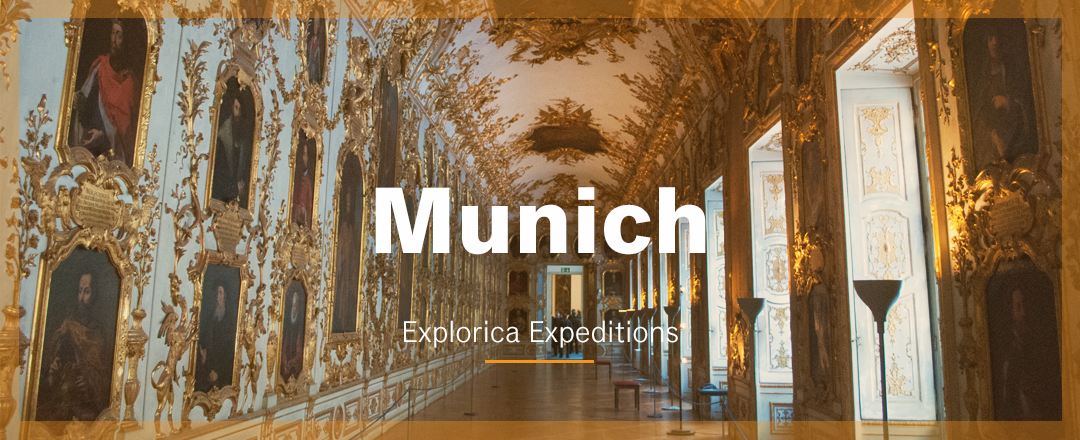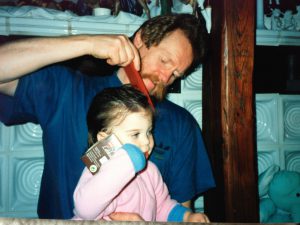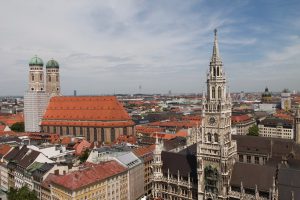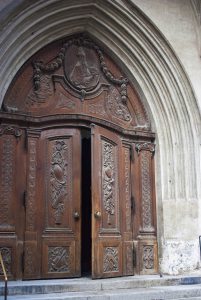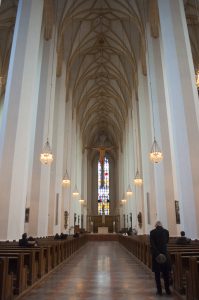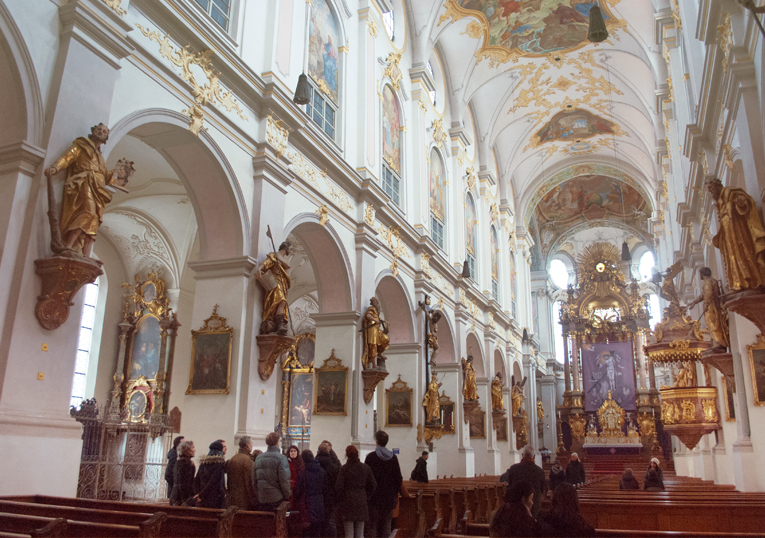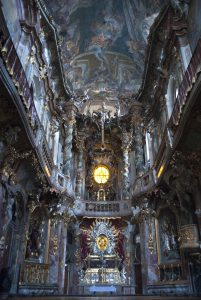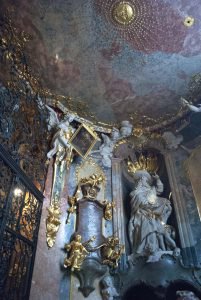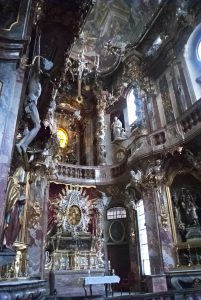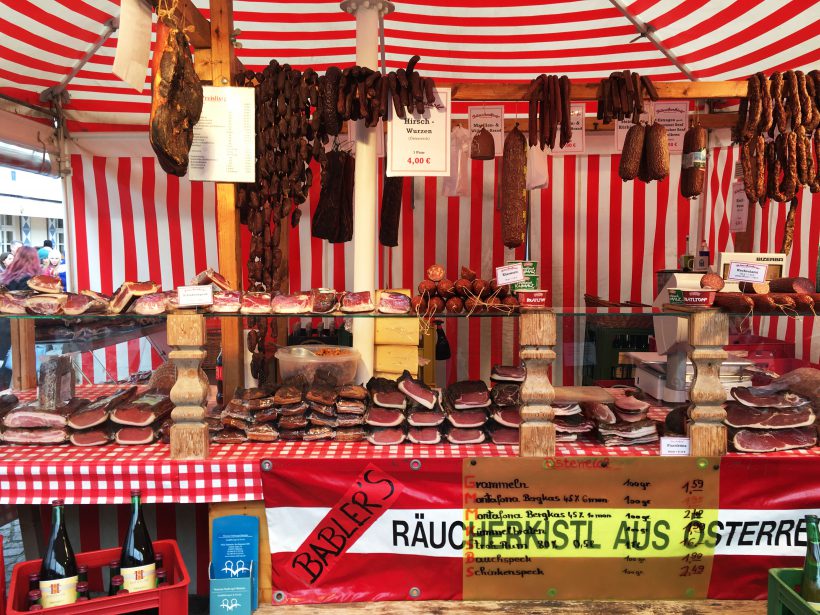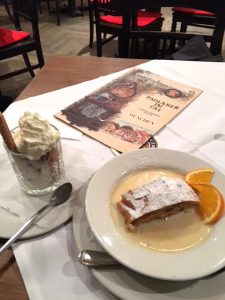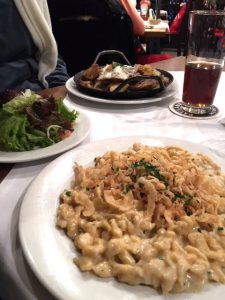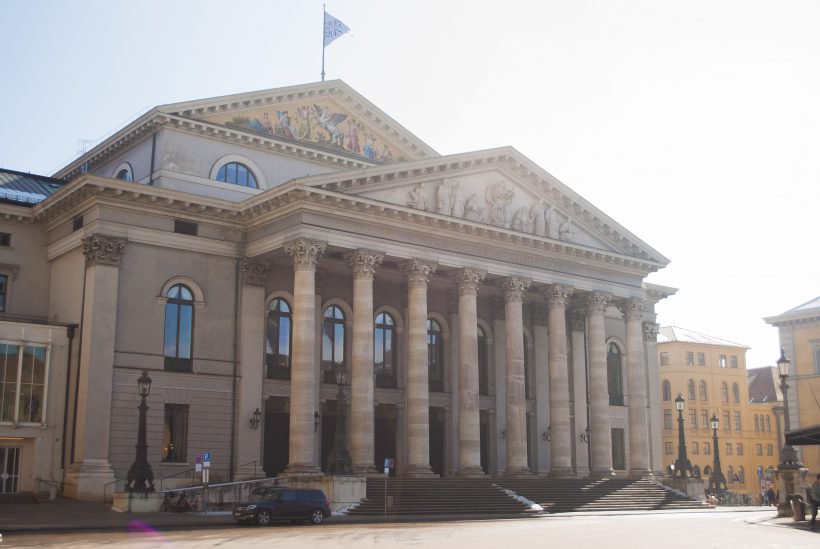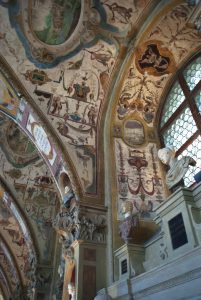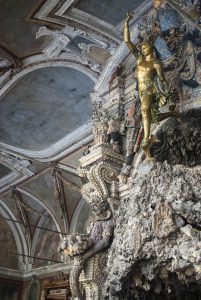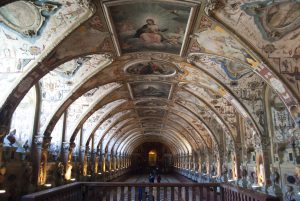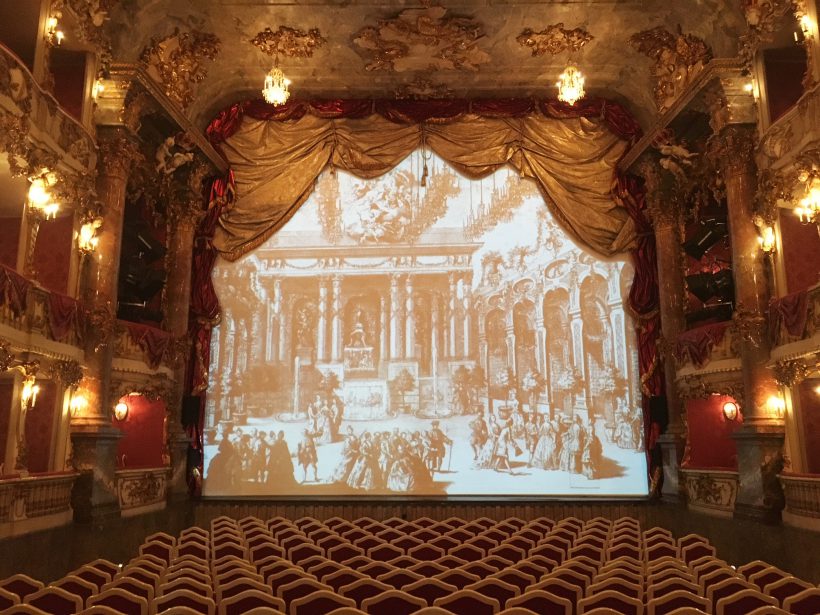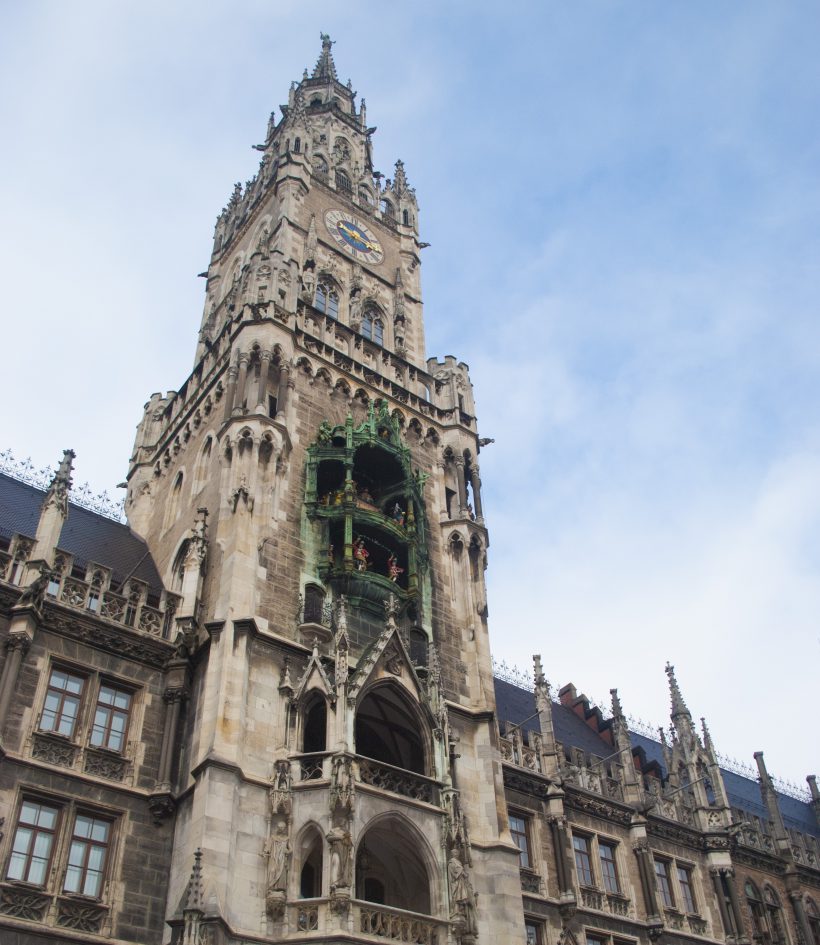 Judith Finn is a graphic designer in Explorica’s Boston
Judith Finn is a graphic designer in Explorica’s Boston
headquarters and has been working at Explorica since June 2017.
She visited Munich this past February, and took in some sights
on our Germany itineraries!
Read her story:
One of my first memories of being in Germany is sitting on my grandparent’s Kachelofen (German tile oven, traditionally used to heat the home) bench in a huff as my step-grandfather attempted to comb out my hair. I couldn’t have been more than three, and it was already my second trip to Germany.
My mother’s whole family moved to Germany in the early 1960s. Over the years some of them moved back and forth, but my grandmother has stayed put. At 87, she’s lived in Germany for almost two thirds of her life. And we, her family, have been loyal pilgrims for all of ours.
But in all that time, the most I had seen of Munich was the airport. Last month I sought to change all that. We had limited time, so I used the Marienplatz as my base, and found four churches, a palace museum, and several other noteworthy attractions within walking distance. All set.
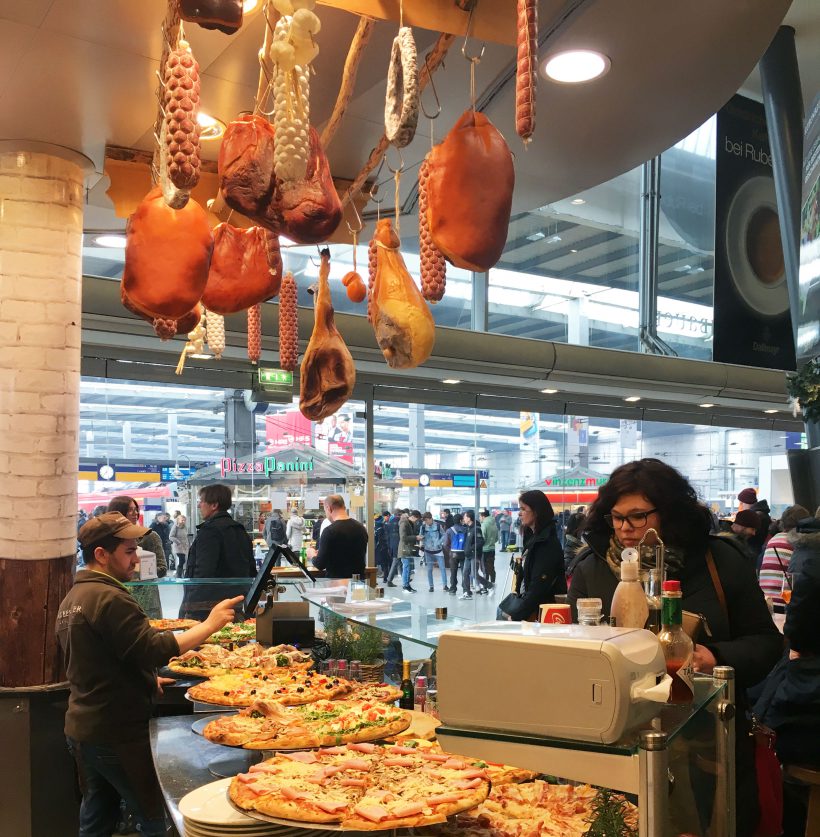
We said goodbye to my grandparents at the Ulm train station, only a thirty minute drive from their home in Zainingen. The ride was about an hour and fifteen minutes, giving us plenty of time to study the U-ban and S-bahn maps. Those are Munich’s two forms of public transportation, an underground system and a series of trams and buses, respectively. After purchasing a day ticket for the trains and trams, we scanned the lunch options. There were so many!
After a quick train ride, checking in, and hopping on the tram (it sounds like a lot of effort, but truly we couldn’t believe how quickly we had gone from our home away from home in the alps to the streets of Munich), we arrived at the Marienplatz.
This central square is named after the marian column built to celebrate the end of the Swedish occupation. Despite its smaller size, it’s one of the grandest city squares I’ve ever experienced. Not as large as Milan’s city center or the spralling Saint Mark’s Square in Venice, the buildings don’t loom over you. They incase you, each as intricate and impressive as the next. The Old Town hall on the east side of the square dates back to 1392. With additions and alterations throughout the ages, its most recent facade was constructed during in the neo-gothic era (1861-64). Its a playful building, like something out of a picture book. The equally impressive New Town Hall (Neus Rathaus) stands in complete juxtaposition. More traditionally neo-gothic, due to the time of its construction, this building dominates the square. The bell tower is 255-feet tall, and houses the world famous Glockenspiel. Gorgeous figurines perform to music and chimes 3 times daily — for nearly twelve minutes. We made sure to be there when the clock struck five, and it was well worth it!
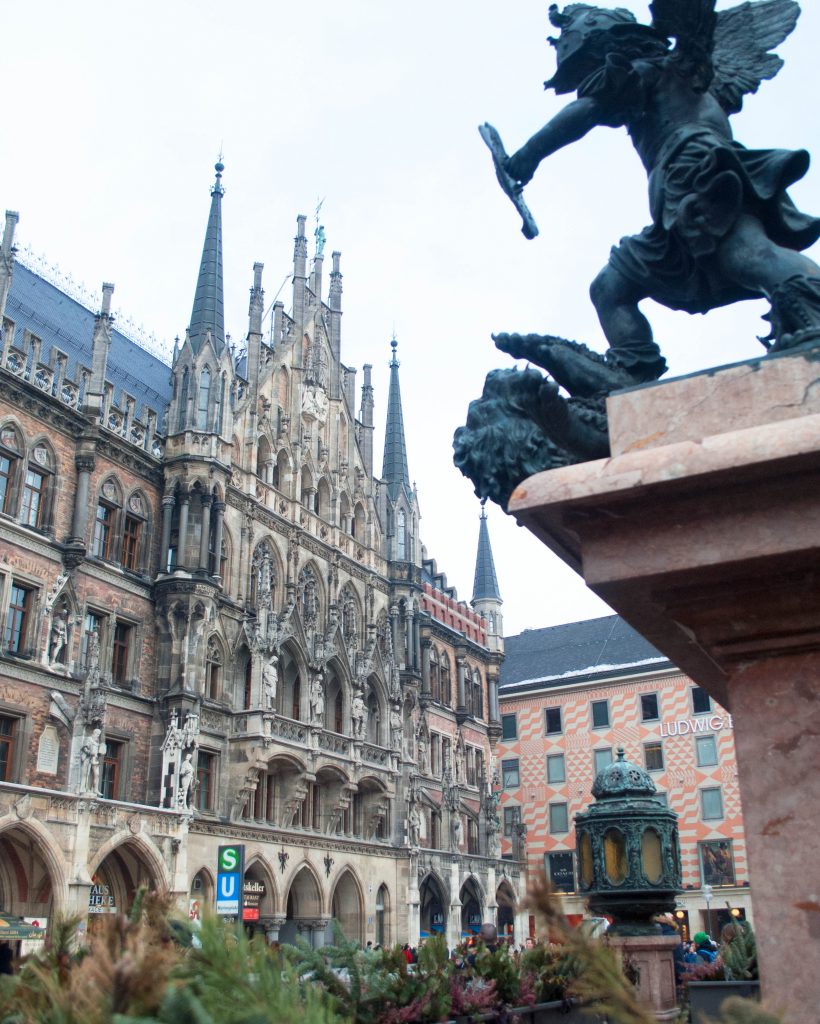
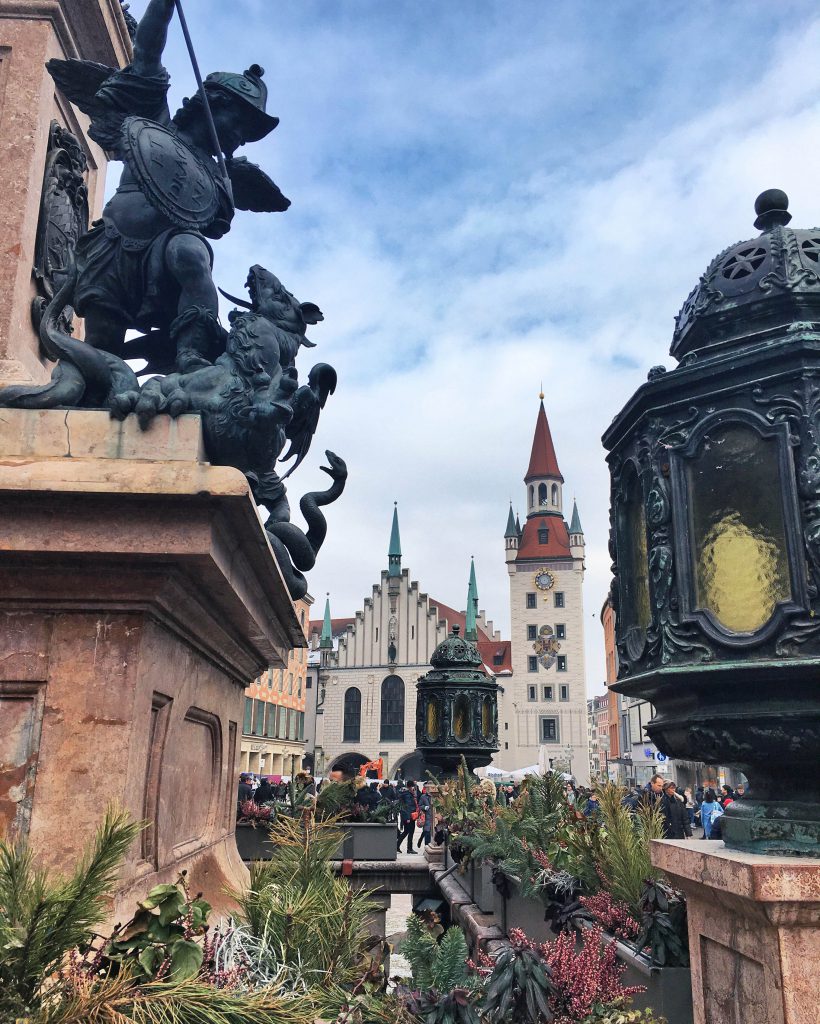
Frauenkirche, or Cathedral Church of our Lady, doesn’t help form the center square, but it’s present in nearly every photo of the area. This relatively modest church has two twin church towers, each terminating in a dome instead of the more ornate gothic-style spire. It’s just as ‘plain’ inside, thanks to budget cuts during the 1460s and 70s.
But who needs ornamentation when you have the footprint of the devil? According to legend, the architect Jorg von Halsbach made a deal with the devil: The devil would provide the desperately needed funds, as long as the church remained dedicated to the darkness. That meant no windows. Once the building was complete, the devil entered the church to admire the outcome. At first he was satisfied, no windows in sight, but as he stepped further into the church, he realized he had been fooled. There was a central altarpiece that covered the stained glass windows at the opposite end of the church. The devil was furious and stomped his foot, forever leaving an imprint on the floor.
St. Peter’s sits on the other side of the Marienplatz. It’s the oldest church in the city, and as such pays homage to multiple architectural styles. Romanesque, Gothic, Rennaisance, Baroque, Rococo … they all come together in one breathtaking result. The 18th-century high altar stands at the far end of the church, and I found the five ceiling frescos that line the way to be particularly stunning.
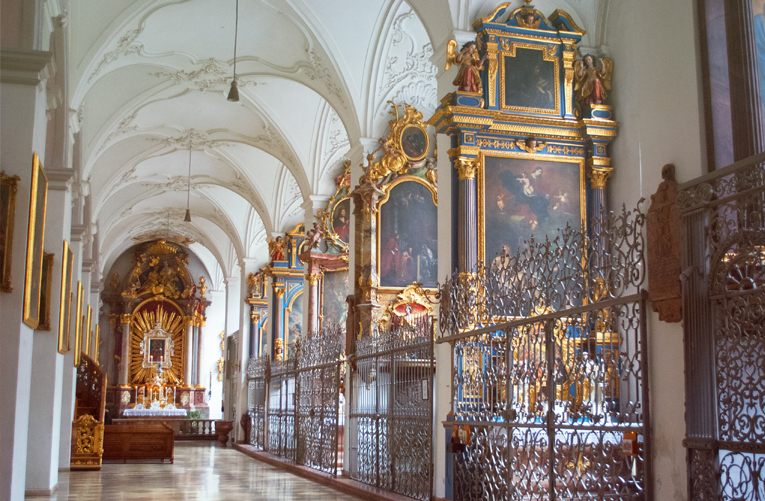
We were moving along rather quickly to make the most of the daylight, so we took the subway a stop over to visit our next church: Theatine*. Both the Rococo facade and the Baroque interior, completed 60 years prior, were unusual for Germany during their constructions. Highly inspired by Italian designs, the interior became a landmark inspiration for constructions across Europe. The contrast between the rich mediterranean yellow of the exterior and the stark white inside is exquisite — the almost overwhelming white is a welcome shock to the system that soon fades to total peace.
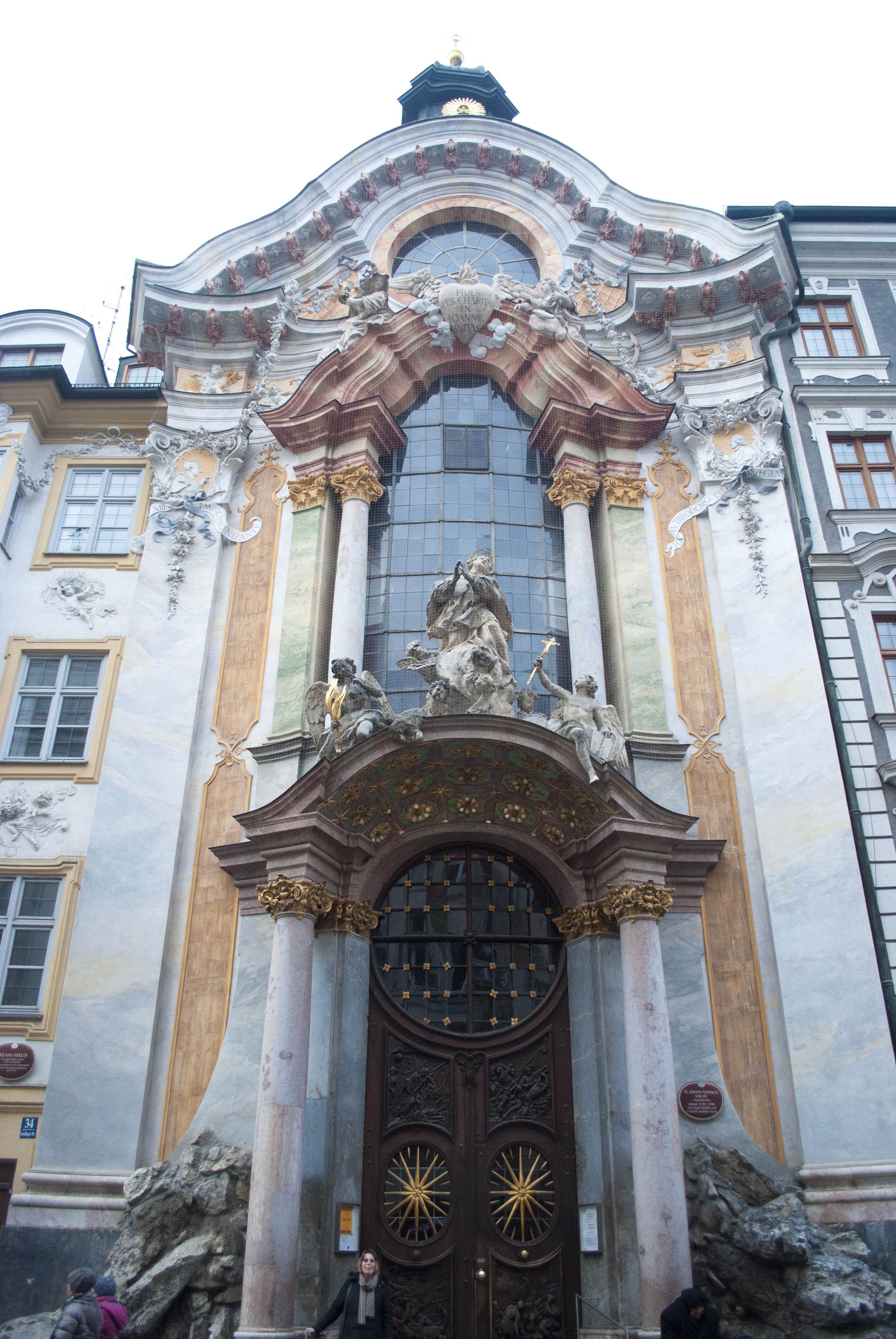
Tucked away on the opposite corner of the Altstadt is Asam Church*. It’s just a seven-minute walk from the Marienplatz, but the architecture of this church couldn’t be more different than that of St. Peter’s or the Frauenkirche.
This Baroque church can’t help but stand out on the bustling Sendlingerstrasse, the heart of the shopping district. It sits opposite a Starbucks and a MAC cosmetics store — every bit representative of Munich as a whole — a surviving gem alongside modern conveniences (when looking at the Glockenspiel in Marienplatz, you need only turn your head to see the entrance to the subway).
Once inside, however, the sights and sounds of the busy street fade away. In its place a veritable wave of intricate artistic details wash over you. It’s a modest size, at less than 25 yards long, and yet more highly decorated than any other building I’ve seen. From the ornate ceiling fresco to the allegorical paintings and sculptures covering every inch of wall, there’s much to take in. The pink and yellow tones renowned during the Baroque era exude drama and exuberance and the multiple sunbursts scattered throughout show off the gold and opulence of the church. It was easily the most memorable sight in Munich, and my favourite church.
With several hours of church hopping under our belt, we head to the ViktualienMarkt* while contemplating what we wanted for dinner. This daily open-air food market has more than 140 stalls selling everything from fruits and vegetables, game and poultry, to wine and olive oil. It became the official town market after the vendors outgrew the space provided by the Marienplatz in 1807. Open from 8am to 6pm (most stalls), it’s the life force of the town. You’ll be tempted to grab a snack or two, but we managed to avoid spoiling our appetites by just browsing the maze of stalls.
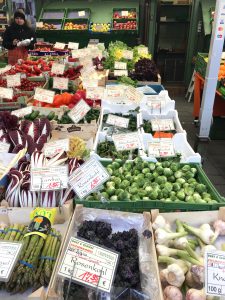
Dinner time! We lasted until the sun faded from view before finally studying the menus posted outside various restaurants. We decided on the brewery-owned Paulaner im Tal. Having already spent a week in Germany, we were eager to focus on what was only on offer in Munich. For me that meant checking out the local cheese that was used in their Kasespatzle, Allgäuer. It was heavenly. My mother had roast pork and dumplings. But the real claim to fame is the apple strudel with vanilla sauce. While strudel originated in Austria, it has become the hallmark dessert across Bavaria, Germany. The recipe can vary regionally, but its basic construction is unleavened, elastic dough that gets stretched thin, and then filled with breadcrumbs and a sweetened cinnamon apple filling. Delicious. Quite full and pleased with all we had managed to see in one afternoon, we took the train back to our hotel.
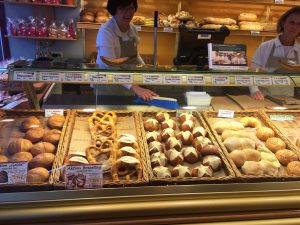 We started our second day with a walk down to the bakery across from our hotel. My mother and I are no strangers to a German roll with tea for breakfast, and we can be quite picky about our bread. Our choice did not disappoint.
We started our second day with a walk down to the bakery across from our hotel. My mother and I are no strangers to a German roll with tea for breakfast, and we can be quite picky about our bread. Our choice did not disappoint.
Suitably fueled for the long day ahead, we grabbed our suitcases and got on the subway. Luckily, the place we were headed had a generous coat room and was able to accommodate our luggage.
The Munich Residence was washed in morning sunlight when we arrived, ten minutes after opening, on our last (and warmest!) day in Germany. What started out as a medieval fortress grew over the centuries to become an extensive compound and the largest city place in Germany. We purchased a complete ticket: The Treasury, the Residence Museum, and the Cuvillés Theatre, and had 3 hours to see as much of it as we could.
The treasury is massive. Crowns and jewels fill room after room. Reliquaries, table settings, clocks, sculptures, chalices… there are over 1,250 works of art to explore. Oh, I’d be remiss if I forgot to mention they have an Ostrich egg cup.
The Residence Museum is equally extravagant. The Bavarian kings have given us palace after palace, one of which is referred to as ‘the Versailles of Bavaria,’ so I shouldn’t have been shocked by the sheer splendor on display. But I was. There are multiple grand halls, bedroom after bedroom, and more mosaic doorways than you can count. An impressive display by any definition, the chief attraction is the evolution of royal representation. You can see the effects of humanism, the Counter-Reformation, the Enlightenment and the principle of divine right in the attention paid to furnishing and decorating each lavish room.
It seemed as if we saved the best for last, because as soon as we we entered the the Cuvilliés theatre I was spellbound. It’s an opera house built for kings, and certainly looks the part. Red and gold cover every inch of the rich Rococo interior — which over the years has been entirely updated and replaced. The only remaining elements of the original theater were removed to safety in 1943 and were reassembled in a court in the residence. None of this dims the theater’s awesome character.
All in all the Residence was well worth the time it took to see — and we could have used another hour to fully explore all that the treasury had to offer. Once we had stayed as long as my transportation calculations would allow, we picked up our suitcases and headed for the train station.
Munich wears its history on its sleeve, and doesn’t apologize for embracing modernity head on. Ancient churches rub shoulders with brand-name storefronts, making this a perfect place to explore the past before hitting the town. As a designer with a passion for art history and architecture, I picked out attractions that would throw me into that expressive past. But there is much to choose from, for every interest.
I’ve been fortunate to see a lot of southern Germany: castles and tiny alpine villages, busy cities and walled fortresses. Munich takes all the charm and energy in these scattered places and rolls them into one. It’s no wonder Munich is the gateway to Germany for many a tourist. I would certainly recommend it as such. Check out one of our most popular Germany tours to see all that you can experience in Munich.
*Not on Explorica itineraries.Talk to your Program Consultant about creating a custom tour that includes this activity!

